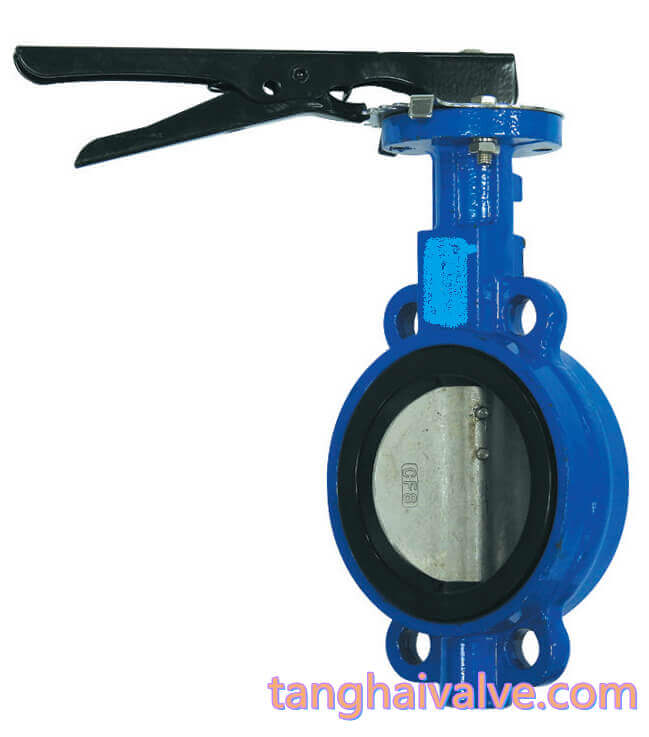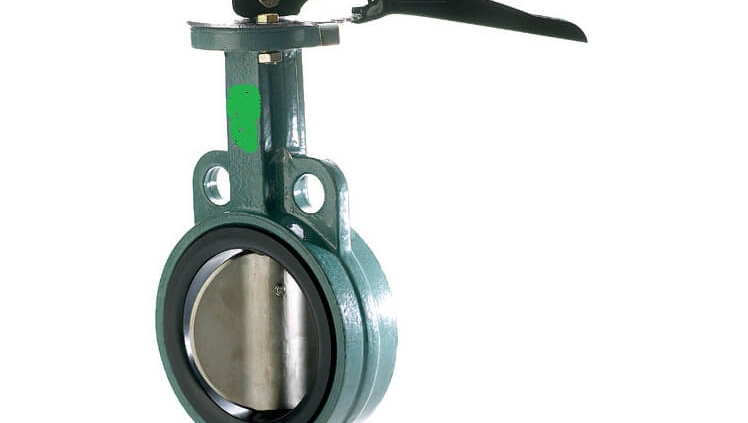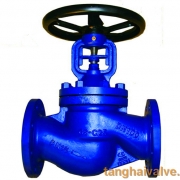Stem structure and Integral Seat of centerline wafer butterfly valve
The centerline wafer butterfly valve can be divided into two types: pinless butterfly valve and pinned butterfly valve. The main difference between them is whether the valve plate and valve stem are fixed with pins. The pinned butterfly valve and the pinless butterfly valve

JIS 10K-wafer butterfly valve-backup seat (1)
correspond to the needs of different working conditions, and more depends on the needs of users. Because the process of the pinless butterfly valve is more effective and more complicated, and there is no pin hole on the surface of the butterfly plate, its price will also be a little more expensive than that of the butterfly valve with a pin. And relatively speaking, it does not appear pitting corrosion and point leakage. Now let’s take a look at the pinless structure of the centerline wafer butterfly valve:
Centerline Wafer Type Butterfly Valve Double Half Shaft Structure
The double half shaft is a kind of structural performance of the midline wafer butterfly valve, also called the square shaft. Corresponding to it is the through shaft. Double semi-shaft means that there is a shaft on the upper and lower sides of the valve plate of the butterfly valve. The upper shaft and the valve stem are integrally formed to act as a transmission, and the lower shaft is a circular shaft, which plays the role of positioning the valve plate. Since the connection between the upper shaft, the valve stem and the valve plate is usually through a square shaft – a square hole, there are also hexagonal connections. Therefore, the processing of the valve plate is usually processed by punching, slotting or EDM, and the processing efficiency is low. In addition, the lower shaft also needs to pass through the through hole at the bottom of the valve body to be installed. After that, a gasket and a retaining ring need to be added to the bottom to fix the lower shaft. The processing and assembly of the valve body also increases the difficulty. Therefore, this structure is only used in large sizes now.
Large and small head shaft structure of centerline wafer butterfly valve
The stem of this midline wafer type butterfly valve is a flat shaft that passes through the valve plate. At the lower end, the diameter is reduced to a size smaller than the flat hole of the valve plate to pass through the valve plate, and the bottom of the valve body is positioned to ensure the valve Concentricity and symmetry of the plate. The processing of the through hole of the valve plate only requires a high degree of coaxiality of the single-side feed. In addition, there is no through hole at the bottom of the valve body, which also avoids external pollution caused by the leakage of the valve body. However, due to the variable diameter of the valve stem and the valve body, the processing cost is appropriately increased, and the upper and lower holes of the valve seat are not of equal diameter, which is easy to cause errors in the assembly process.
Equal Diameter Flat Shaft for Centerline Wafer Type Butterfly Valve
The structure of this midline wafer butterfly valve is evolved from the structure of the large and small head shafts. The valve stem is an equal-diameter shaft. The bottom is processed into double D type and the valve plate forms a close fit to ensure the transmission of the valve plate. It is also a flat hole, but the direction of the flat hole is rotated by a 90°, so as to ensure that when the valve is at the closing point or close to the closing point, the valve stem is in contact with the valve body bushing with a circular surface to ensure the symmetry of the valve plate and the same The axial degree can not only avoid the bending deformation of the valve stem but also make the valve close tightly. Since the valve body and seat are the same size in both directions, the efficiency can be greatly improved during processing and assembly. This kind of structure is simple and practical, and has the characteristics of high processing efficiency, quick assembly, tight coordination, economical saving and so on.
We all know that the seal of the centerline wafer butterfly valve is inseparable from the sealant sleeve, and the integral sealant sleeve is actually a wafer-type butterfly valve with a reliable sealing and leak-proof valve seat. It includes the annular valve body of the upper and lower valve necks, the annular valve seat embedded on the inner wall of the valve body, the butterfly plate, and the valve body which is rotatably installed on the valve body through the valve seat and the butterfly plate through the upper and lower valve necks. The valve stem and the transmission device, the valve seat is composed of an annular skeleton and an integral sealant sleeve formed integrally with it.
The integral sealant sleeve of the midline wafer butterfly valve consists of an inner wall sealant layer covering the inner wall of the skeleton and an end face sealant layer covering the two ends of the skeleton respectively. It is characterized in that the two end-face sealant layers are divided into a circumferential extension edge covering the end face of the annular valve body, and the extension edge of one end-face sealant layer is integrally and fixedly connected with the end-face sealant layer. The fixed epitaxial edge of the end face sealant layer on the other side and the end face sealant layer are detachably connected movable epitaxial edges.
The birth of this midline wafer butterfly valve seat is that the butterfly valve, as a fluid pipeline valve, has very strict requirements on its tightness. However, the current wafer butterfly valve still has the problem of running and dripping, which affects the normal use. Therefore, how to improve the structure of the valve seat has become a concern. However, the integral sealing valve seat, which is reliably sealed against leakage, can completely cover and seal the joint between the valve seat and the annular inner wall of the valve body. Therefore, it can effectively prevent the fluid in the pipeline from entering the valve body, effectively avoid the leakage of the valve caused by engineering construction and other reasons, and ensure the normal operation of the valve. In addition, the structure of the fixed epitaxial edge and the movable epitaxial edge is also convenient to assemble and use. While ensuring the quality of the project, it saves costs and is suitable for market promotion.
TH Valve is a professional manufacturer of butterfly valve, gate valve, check valve, globe valve, knife gate valve, ball valve with API, JIS, DIN standard, used in Oil, Gas, Marine industry, Water supply and drainage, fire fighting, shipbuilding, water treatment and other systems, with Nominal Diameter of DN50 to DN1200, NBR/EPDM/VITON, Certificates & Approvals: DNV-GL, Lloyds, DNV, BV, API, ABS, CCS. Standards: EN 593, API609, API6D
Related news/knowledge:
Stem structure of centerline wafer butterfly valve
Reasons and solutions for leakage of valve sealing surface
Characteristics of the centerline wafer butterfly valve
Centerline flange butterfly valve

 tanghaivalve.com
tanghaivalve.com tanghaivalve.com
tanghaivalve.com

 © Copyright 2020 Tianjin Tanghaidongyang Valve Co., Ltd. All Rights Reserved.
© Copyright 2020 Tianjin Tanghaidongyang Valve Co., Ltd. All Rights Reserved.